When Tom and Jerry cartoons debuted in 1940, cat-and-mouse cartoons were already considered old-fashioned. Thankfully, the legendary animation team of William Hanna and Joseph Barbera envisioned a great opportunity.
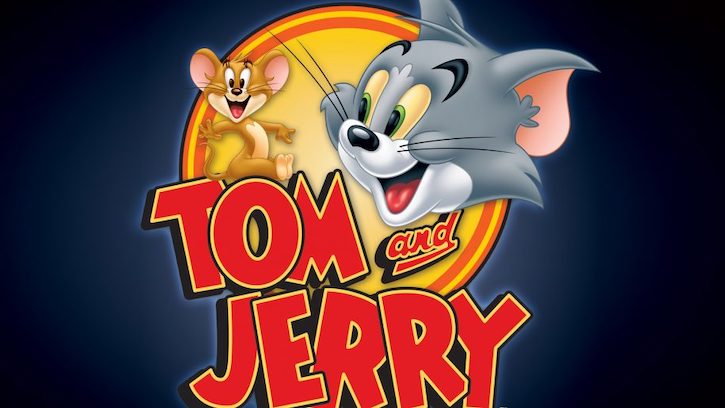
The duo managed to convince their bosses at MGM to take a chance on what was yet another theatrical short about a frisky feline chasing a cute mouse.
We’re talking about the most Oscar-lauded animated iconic duo of all time. That’s right, Tom and Jerry have won more Academy Awards than any other cartoon team.
Tom and Jerry Clips
Creating the perfect pair to bring Tom and Jerry together took the teamwork of another classic cartoon couple, Hanna and Barbera. This writing and directing team also made the Flintstones, Yogi Bear, and Scooby-Doo and worked at MGM’s rookie cartoon studio during the 1940s.
It all began with one real theatrical short, Puss Gets the Boot, starring Jasper, a cat and a mouse named Jinx. The studio was less enthused about falling into the familiar cat-and-mouse cartoon formula.
Hanna and Barbera almost changed their cartoon idea to a dog and a fox in response. Still, they were saved by an Academy Award nomination, and the strong audience reaction, of course, dispensing of the Jasper and Jenks Moniker was the first significant change.
The studio put on a contest with a $50 prize that led to the creation of the cartoon cat Tom and Mouse Jerry, a name that was then most familiar as a warm eggnog cocktail.
Animator John Carr came up with the names first introduced in The Midnight Snack in 1941. Hanna and Barbera worked on Tom and Jerry until the closing of the MGM cartoon studio in 1958.
The secret weapon was composer Scott Bradley throughout the new show version, who scored all of the original shorts. His jazz and classical music mix was a vital part of conveying emotions for characters who rarely talked in the newest 2014 rebirth.

Three composers have been used throughout the Tom and Jerry run. John van Ton Garen composed 36 episodes, David Rickard composed 26 episodes, and Vivek Mandala composed 24.
Since the end of the original series, Tom Cat and Jerry has been revived many times by different animation studios and cartoon artist teams. The series jumps from various MGM subsidiaries before heading to the Hanna and Barbera studio for TV and finally landing at Warner Brothers animation.
The Warner Brothers studio was famous for producing the Looney Tunes characters. Tom and Jerry’s life as Warner Brothers cartoons began in 2002 with their first of 13 direct-to-video feature films.
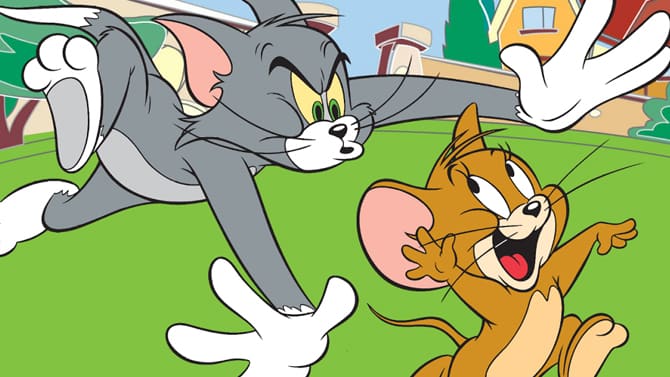
While the initial release had Hanna and Barbera’s producers, these movies eventually became cash grabs with silly crossover themes.
Some of the most egregious examples include Tom and Jerry in The Wizard of Oz, Tom and Jerry Meet Sherlock Holmes, Tom and Jerry Blast Off to Mars, and Tom and Jerry Willy Wonka and the Chocolate Factory.
The duo’s current TV series, the Tom and Jerry Show, is an attempt to regain the spirit of the original shorts.
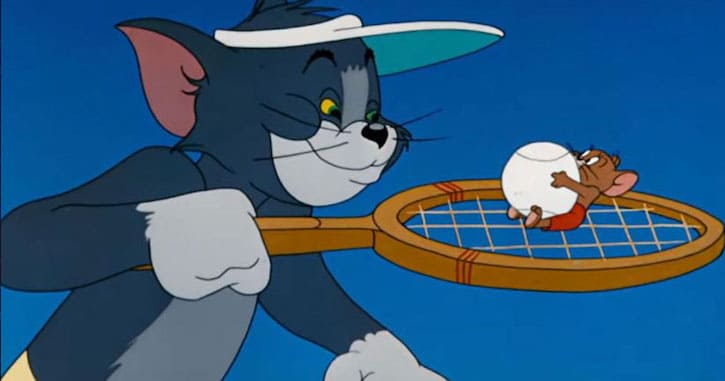
Tom and Jerry Mouse settled into a regular formula right off the bat. This involved Tom going to great lengths to catch and inflict harm on Jerry.
Usually, the smaller but quicker Jerry finds a way to outsmart his enemies by the end of the short, and Tom ends up being on the wrong end of most of the carnage.
Many of the classic episodes featured a minimal plot. They’re mostly a series of humor gags strung together. Barbera developed the stories while Hanna oversaw the animation, and Barbera eventually built upon the standard setup over time.
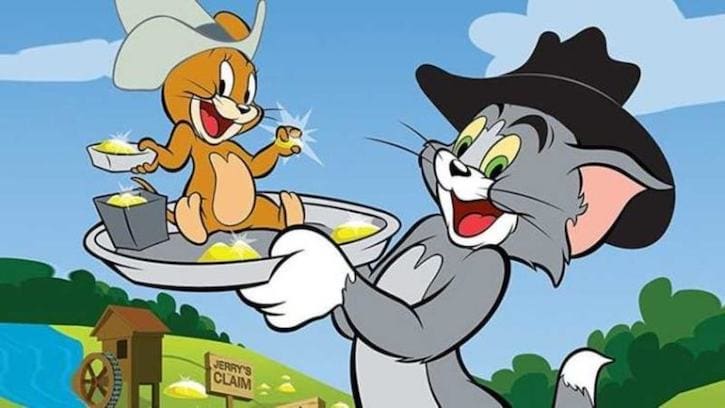
Tom’s owner or other animals would enter the mix to add another dynamic to the cat-and-mouse battle. Tom would be trying to impress a female cat in some shorts or have a good time until Jerry ruins the fun.
The Tom and Jerry Show, which has run on Cartoon Network since 2014, was deliberately molded on the sensibility of the Hanna and Barbera theatrical releases.
Most of the 11-minute shorts involved the title duo plotting against each other. Like in the old series, Tom and Jerry are pretty much mute. The only sounds they make are howls of pain after getting hurt. Even Tom’s classic, “AAAUU,” is faithfully reproduced in the new series.
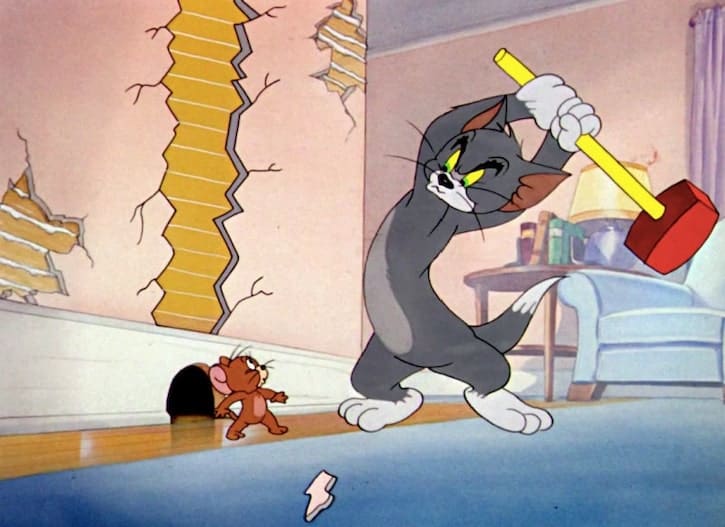
Many classic side characters such as Spike, Quacker, and Tyke are worked into the new storylines. However, Spike, the Bulldog who always has it out for Tom, plays a more significant role in the new show.
He gets most of the lines and often furthers the plot. In interviews, executive producer Sam Register said he wanted the new show to bring the characters into a more contemporary world.
This means making the surroundings more modern and including technology from the 21st century. The pet’s new owners, Rick and Ginger, are also much more of today’s era, and they’re generally friendly to animals.

The first human character from the original series was Mammy Two-shoes, an offensive portrayal of a housemaid with a penchant for walloping Tom with a broom.
While the average suburban home makes the perfect Tom and Jerry setting, even Hanna and Barbera began taking their characters out of the living room by year three of the series.
Some of the most beloved episodes involved Tom and Jerry in a completely different place in time. Take the 1952 Academy Award-winning short The Two Mouseketeers, for example.
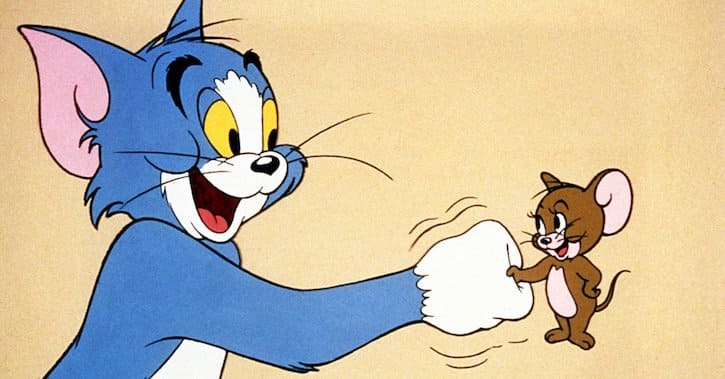
This fan favorite is set during the sword-wielding days of 17th-century France. Even though Tom gets the guillotine at the end, MGM made three Mouseketeers sequels.
Other classic short stories like Robin Hood featured holiday themes or involved the duo interacting with guest characters.
Hanna and Barbera completely shunned any chasing in 1945 Mouse in Manhattan, centered on Jerry taking a trip to the big city. By the end of the original series, most stories took Tom and Jerry out of the house or involved multiple secondary characters.
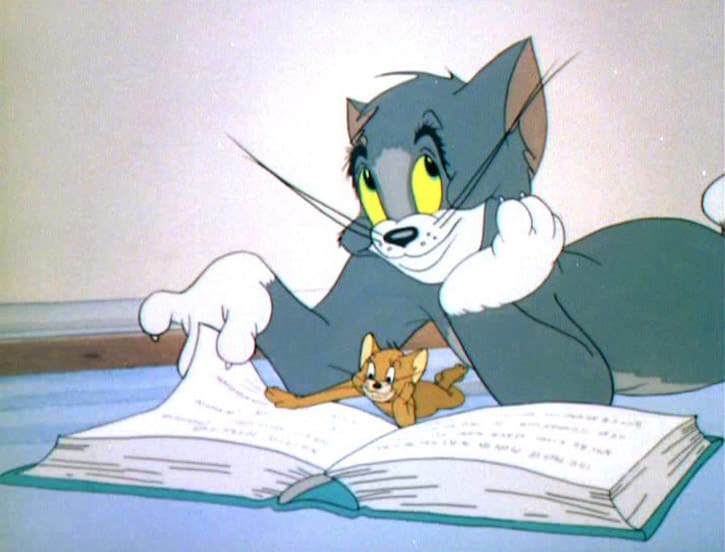
The Tom and Jerry show seems to pick up where the original Hanna and Barbera series left off in the 1950s. Many episodes have updated settings and tend to focus on side characters.
Spike, rather than Tom, gets kicked out of the house at the end of the first show in a strange reversal of fortunes. In addition to the plots revolving around the typical cat and mouse antics, the Tom and Jerry show features episodes showcasing the title characters.
The duo ran an agency called the Cat and mouse detectives to feature a film noir sensibility complete with narration in shadowy art. Tom and Jerry usually team up to solve a mystery involving recurring characters like toodles galore or butch cat.
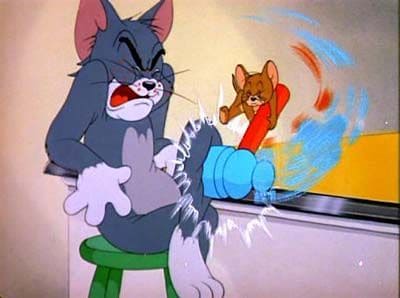
There are also standalone shorts in which Jerry lives in a lab with his rat friend Napoleon and plots that involve two witches named BD and Hildy.
Most of the fast-paced action is based on the original cannon mass rivalry. After all the reboot was created by Bob Jakes, an animator who got his start with another slapstick cartoon duo, Ren and Stimpy.
The actual animation is the most apparent difference between the classic Tom and Jerry series and the modern incarnation.
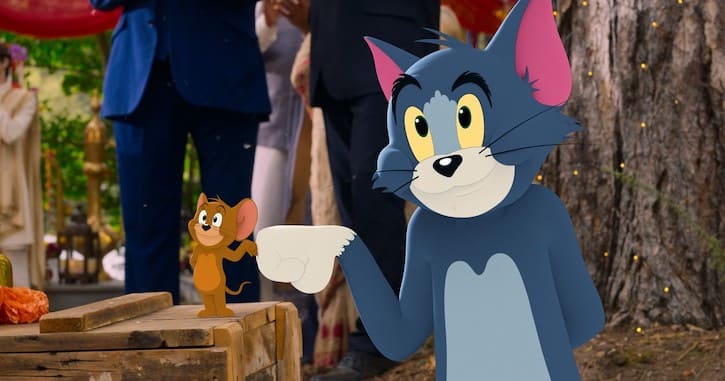
Jakes and the company may have been after an artwork style that evokes the original’s bright colors and fast movements, but the new show looks completely different.
This is due mainly to the current series using the animation hybrid, flash animation, a relatively low-cost digital production method used in many modern shows.
The result is a more computer-based look with crisp lines and slight shading or shadows. Classic gags like wild takes and eye pops don’t have the same effect when animated on a computer.

The original MGM cartoons were created via cel animation, which requires drawing every frame by hand.
Since Hanna and Barbera used 24 frames a second, a typical seven-minute Tom and Jerry cartoon involved more than 10,000 pictures. The process was laborious, but the final releases looked fantastic.
Most industry buffs and fans agree. Tom and Jerry had some of the most lovely animations of its day. Considering the time and cost of traditional animation, it’s no surprise that the Tom and Jerry show has embraced the more feasible Adobe Flash approach.
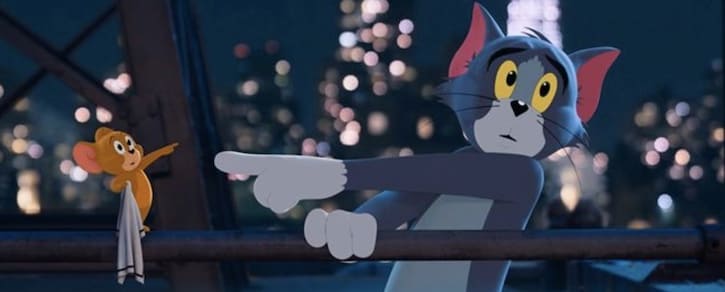
The new animators turned out more animation shorts in two seasons than what the MGM team released in the original run.
While Tom and Jerry have never really aged, their looks have evolved over seven decades. Tom has mainly gone through some striking stylistic changes at the hands of animators.
In the 1940 debut, he had a round face and some wild fur. Many of the classic visual traits were already there: a blue Krait coat, yellow eyes, and a white tip on his tail.
However, the early Tom acted more like a real cat and had a thick patch of white fur between his droopy eyes. By the late 40s, Hanna and Barbera streamlined his slow, adding prominent eyebrows and giving him more human-like traits.
This Tom was more likely to stand on his two legs and use his paws like hands. In comparison, Jerry has changed very little since his debut. He was designed from the very beginning to be a cute comedic foil who enjoys inflicting pain on Tom when it’s deserved.
Aside from a brief stint wearing a red bow tie in the 70s TV series, he’s pretty much remained the same brown mouse around. The animators based their character designs on the classic Hanna and Barbera renderings in the Tom and Jerry show.
However, the flash animation gives a more streamlined look with bold, solid colors. The animators did go through a lot of effort to bring Tom and Jerry’s exaggerated facial expressions into the digital realm.
Tom and Jerry were created when most cartoons were shorts shown alongside feature films at movie houses. All the shorts had to fit into one reel, which could hold about ten minutes of the film.
At the end of the 1950s, animation studios were no longer making enough money to justify creating new shorts. When MGM closed its animation division in 1958, thus ending the original run of Tom and Jerry, Hanna and Barbera already had their studio primed to bring cartoons to TV.
However, Tom and Jerry’s life in the movies wasn’t over. MGM commissioned Prague-based director Jean Deach to bring back the series in 1961.
This offer got an era of Tom and Jerry led to some pretty bizarre theatrical shorts. Perhaps it was due to the low production values or to ditch using the Eastern European crew that wasn’t familiar with Tom and Jerry, but this era feels like a completely different series.
Reverb-heavy sound effects, quirky artwork, and weird plot lines marred the deep shorts. For example, in Mouse Into Space, Jerry takes a rocket ship to the moon to escape Tom’s torment.
The Deach era also featured a sadistic middle-aged man as Tom’s owner. Distraught and lonely over the loss of his friend, Tom turns to booze. This ill-tempered grouch seems to take a cruel joy from pummeling his pet.
MGM decided to step up its game in 1962 and hire legendary director Chuck Jones to take over Tom & Jerry. As a creative force behind many Warner Brothers cartoons, Jones brought a Looney Tunes sensibility.
Many of these Tom and Jerry shorts are reminiscent of his old Roadrunner Coyote releases. While these shorts were popular, Jones later admitted that he couldn’t handle the characters as well as Hanna and Barbera did.
A few years before the MGM animation studio closed again in 1967, Tom and Jerry finally transitioned to television. The old shorts played on Saturday mornings, and Hanna and Barbera even introduced a new Tom and Jerry TV show in 1975.
Various TV versions of Tom and Jerry popped up throughout the 80s and 90s. This includes the child Toon series Tom and Jerry Kids, the most recent 2014 version launched in Canada on Teletoon in March 2014 and began airing in the US on Cartoon Network in April 2014.
In March 2017, Time Warner’s Turner and Warner Brothers announced the launch of their boomerang streaming service, which would have to add free cartoon episodes available, including the Tom & Jerry show. Who knew this cat and mouse from the 40s would make it to the Internet?
The side effect of bringing Tom and Jerry to TV was the inevitable complaints from parent groups. Let’s face it: Tom and Jerry were in some of the most violent cartoons of animation Golden Age.
Who could be surprised that some people took issue with a cat and mouse attacking each other with bombs, knives, and shotguns? The level of mayhem was most famously spoofed by The Simpsons cartoon within a cartoon the Itchy and Scratchy show.
When Tom and Jerry episodes were created for television, the violence was toned considerably. In the 1970s, Hanna and Barbera’s show, The Count Mouse, were suddenly pals who traveled the world and embraced new adventures.
There were always undertones of friendship between the two but removing the chase element alienated many fans. Like it or not, over-the-top, consequence-free violence is a significant source of humor for Tom and Jerry. After all, physical comedy is the number one type of comedy.
The Tom and Jerry show strikes a balance between the two extremes. While the current episodes feature plenty of fast-paced action and physical humor, the violence is no longer excessive.
Don’t expect to see Tom brandishing firearms in any future episodes. Also gone are the occasional scenes of characters enjoying cigars or getting drunk.
However, the producers deem punching, strangulation, and grenades fair game, so fans and animators can have fun with that.
Many younger viewers are unaware of Tom and Jerry’s impact on generations of animators. Kids these days can easily search for Tom and Jerry on YouTube and watch hours of the funny classics.
The new show updates the original premise and presents a classic cat-chases-mouse story to viewers who may not otherwise have been interested in watching cartoons from the late 1940s.
The Tom and Jerry show also aims to overtake the mantle previously held by the various programs and other releases since the original series ended.
As mentioned earlier, since the year 2000, there have been thirteen straight-to-video Tom and Jerry movies, most of which were geared towards family viewing and weren’t as faithful to the original.
Most die-hard fans also try to forget about Tom and Jerry’s one theatrical film: The Movie. This poorly reviewed film from 1992 included spoken dialogue between the title characters.
In 2021, Tom and Jerry were brought back to the movie theaters by Warner Bros. in a feature film with a live-action cast. The cat and mouse city chase delighted younger audiences; however, the Tom and Jerry new movie had mixed reviews overall.
The Tom and Jerry cast included live-action stars like Chloë Grace Moretz, Michael Peña, Colin Jost, Jordan Bolger, Rob Delaney, Patsy Ferran, Pallavi Sharda, Somi De Souza, Ken Jeong, and more by director Tim Story.
At the very least, the Tom and Jerry film brings the duo back to their familiar formula. Though the purists may have a hard time taking in the new computer animation, those who genuinely love the characters will be happy to see their favorite cartoon duo back in action.

Brandon Crombar
Editor In Chief / FounderBrandon is an animation enthusiast and animated film critic. He has been writing about animation since 2013 to celebrate animated movies, characters, and songs. His favorite animated movies include Finding Nemo, Aladdin, and The Lion King.



